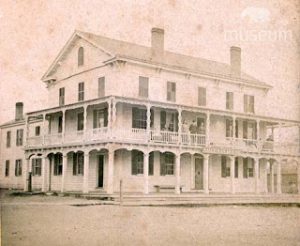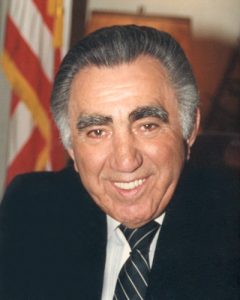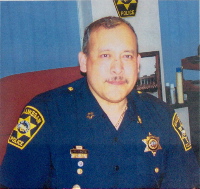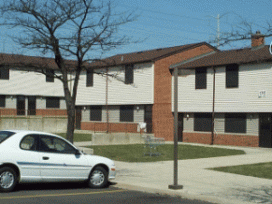| Nicknames | Wauk-Town | |
|---|---|---|
| Settled by | Provide info | |
| Year infiltrated | 1978 | |
| Crime impact | Part | |
| Worst areas | Sunset Avenue to Golf Road on the north, Belvidere Road to 14th Street, Western Avenue to Pine Street on the east, GreenBay Road to Bay Place to Lawrence Avenue on the west |
|
| Suburban projects | Barwell Manor, Armory Terrace, Whispering Oaks |
This area was first settled by the white man in the year 1725 when French fur traders established the Little Fort trading post. For the next 35 years French and Indian traders would pass through and stop at this post until the post was removed in the year 1760 during the French and Indian War.
In the year 1829 the land was officially signed over to the U.S. government by the Indians living on the land, and the first permanent settler was Thomas Jenkins that built his house right by the lake front.
After the Little Fort area became the county seat of Lake County in 1841, more settlers began to make Little Fort their home and the population grew to 150 residents by 1844 mainly thanks to the city’s first industry the Custom Flour Mill that opened in 1841, then to 750 just two years later in 1843. By the year 1849, the town’s name was changed to Waukegan which means “fort” or “trading post” in Pottawatomie language. In 1855 the Chicago & Milwaukee Railroad brought easier transportation in and out of the city which further stimulated a population boom. Wollen Manufacturing Company, a second mill opened its doors in 1856 which brought more employment and settlement. In the year 1859 the village was officially incorporated because now the population soared to above 2,500.
German immigrants began settling in the new city in the 1860s as they found many sources of employment thanks to both the railroad and the fact that Waukegan used Lake Michigan to ship the manufactured goods out of the city. More new industries were prevalent by the year 1870 such as: Waukegan Hide and Leather Company, Waukegan Shoe Company, Glen Flora Stock Breeding Association and Beasley’s Waukegan Ale Brewing Company that opened in 1868.
The population of Waukegan exploded again in the 1890s decade when more new manufacturers came to the city such as: United States Sugar Refinery in 1890, United States Starch Works in 1892, Washburn and Moen Wire Mill in 1892 and Thomas Brass and Iron Works in 1895. The Washburn Moen plant became the largest employer in the Waukegan and North Chicago area, the building of the plant even prompted the southern part of Waukegan to be annexed away into its own village of North Chicago, regardless, the plant employed thousands of Waukegan residents. The new industries caused the population of Waukegan to soar to over 9,400 residents by 1900.
In the early decades of the 20th century more migration came to Waukegan as Swedish, Finnish, Lithuanian and Armenian immigrants came looking for employment opportunities. Many new industries opened their doors outside of the city in neighboring Lake County suburbs that drew more interest in the settlement of Waukegan. In the 1920s, African Americans first began settling, mainly on the south side of the city and by 1930 there were over 1,000 African Americans living in Waukegan.

As African Americans were moving into Waukegan there was unrest from many white residents that did not want to live among blacks, this was apparent of the night of May 31, 1920. On this night a group of black youths got into mischief and were hurling rocks at passing automobiles on Sheridan Road. One car they ended up hitting was the automobile of U.S. Navy Lieutenant Mrs. Blazler that ended up shattered her windshield as the pieces of glass cut her. When word reached the Great Lakes Naval base in nearby North Chicago many U.S. Navy and U.S. Marine Corp personnel became angry and stormed the Sherman House Hotel (pictured) which was a hotel that catered to African Americans. Hundreds of sailors and Marines gathered outside the hotel shouting “Lynch Em!” Eventually the crowd of sailors became uneasy and began throwing several objects at the hotel and smashed the windows, they entered the hotel and began overturning furniture while African American guests fled in terror. Waukegan police arrived and stopped the riot but also discovered many sailors and Marines chased down many blacks and were trying to beat them up or worse, police came and rescued as many victims as they could, the riot was eventually put down (Chicago Tribune Page 1, June 1, 1920). This was an example of racial strife in Waukegan as African Americans began migrating to the city. Even though the police put down this unrest, the Chief of Police and State’s Attorney were members of the Ku Klux Klan which showed that the Klan had power in the law enforcement sector of Waukegan. This case in 1920 also shows how the actions of a few black youths caused the attack on several black residents as retaliation even though the victims attacked in and near the hotel by the military personnel were in no way involved with these kids that threw rocks and may not have even known them, the fact that the boys that threw the rocks were black caused backlash against all blacks, which is most definitely a form of racism when people are punished because of their skin color.
Waukegan continued the grow in population in the mid-20th century and more African American and Puerto Rican residents settled on the communities’ south side in the 1950s and 1960s. This area became an economically depressed area as many of the black and Puerto Rican residents pulled in very low incomes and lived below the poverty line. Many houses in this area were dilapidated and trash became a major problem, the area was regarded as a slum area and in need of public housing and slum clearance.
Greaser gangs came to Waukegan very early in history. They were here since at least 1955 and perhaps existed well into the 1970s. I only have evidence from 1955.
In the year 1960, plans were underway to clear out much of the slums and build public housing complexes. By 1962 work was underway to convince residents on the south side to sell their homes and relocate or move into public housing, many complied and the demolition and construction began. The slum clearance occurred in 1962, while the construction began in 1963. In the year 1965 Barwell Manor that consist of two story row houses was complete that is located at Genesse Street and South Ave on the south side. Armory Terrace was also complete in 1965 and was built at Clearview and McAree road; these were also two story row houses. In the year 1966, Whispering Oaks projects were completed which was more two story row houses (Chicago Tribune page 5, October 26, 1961) (Chicago Tribune North Neighborhood News, November 7, 1965).

Racial differences in the community and income inequality reached its breaking point in 1966 when several black and Puerto Rican residents rioted in Waukegan over the mistreatment of minorities in the city; this led to negotiations with the city’s mayor Robert Sabonjian (pictured) to desegregate schools and other facilities, although there was some progress made the poverty on the south side was still a major issue. Another public housing unit was constructed in the late 1960s that became a 10 story apartment complex for elderly residents and families.

In the late 1970s, much of the local industry began to close down that severely effected Waukegan and neighboring North Chicago. Thousands of jobs were swept away from Waukegan residents that especially devastated the black and Latino community on the south side. After the economic devastation of the late 1970s, crime and street gang activity soon followed that started on the south side of the city in 1978 near the public housing projects when a street gang formed called the Kingsmen. The Kingsmen was a Waukegan born street gang that multiplied into about 15-20 members, Waukegan police first identified this gang in 1979 along with two other street gangs in the projects according to Deputy Chief Miguel Juarez (pictured) and Captain Stevenson in their interviews with the Chicago Tribune, Juarez said the two other gangs besides the Kingsmen died out in 1979 which shows that the Kingsmen wiped out their competition (Chicago Tribune Andrew Martin and Jerry Thomas September 5, 1993) (Chicago Tribune Gary Moore October 4, 1998).
The Kingsmen were the first gang in the late 1970s but soon Chicago based street gangs entered the suburb by 1980 and at first they arrived in and around the public housing projects. The Conservative Vice Lords, Black P Stones and Black Gangster Disciples arrived from Chicago in the early 1980s and began to slowly recruit in the community. Many two parent household families began to pack up and move out of the south side in the early 1980s and the families were replaced by single parent low income or no income families that were trying to move to the suburb to bring their children a better life away from the street gangs of Chicago, little did they know that their children would instead spread the word of their gang onto the streets of Waukegan. The Kingsmen fought these Chicago based street gangs but eventually lost the battle and the Kingsmen went extinct in the mid-1980s.
In the early 1980s, Latino street gangs from Chicago started factions in the suburb such as: Orquestra Albany, Latin Lovers, Latin Disciples, Insane Unknowns and Latin Kings. Later in the 1980s and into the 1990s Latino gangs like the City Knights, Insane Spanish Cobras, Satan Disciples, Insane Majestics and Spanish Gangster Disciples infiltrated the suburb. Black street gangs like Black Disciples and Four Corner Hustlers had infiltrated the suburb by the 1990s as well.
In the 1980s, gangs became a major issue in the suburb of Waukegan as crime was rising higher as gangs were battling each other for territory in the suburb, Waukegan now had a bad reputation as one of the more dangerous suburbs in the Chicago metropolitan area; however, murders and excessive violent crime were not a major issue in the suburb back in the 1980s. The suburb had hundreds of gang members by the late 1980s but the violence was not out of control until 1991.
In a 1991 Chicago Tribune article that discussed a little bit about Waukegan gangs Sergeant Fernando Shipley stated that there were about 700 gang members in the suburb with about 250 of them known as hard core members; however, he also stated that the gangs of Waukegan were not very sophisticated and there was no connection between Chicago and Waukegan (Chicago Tribune Jerry Thomas, August 28, 1991). Perhaps the gangs were not very sophisticated in the suburb back then but one thing Shipley was wrong about was the Chicago and Waukegan connection not being there, at the time it was not identified but later in the decade it would be. This article was written in wake of a violent incident that stirred the Waukegan community after a 15 year old boy was beaten into a coma after he wanted to leave the Latin Lovers street gang. According to court documents on the day of August 15, 1991 Latin Lovers gang members Roberto Dominguez, Carlos Cortez, Victor Morales and Francisco Aguirre and Keith Smith entered Yeoman Park in order to give Keith Smith a three minute long violation out of the gang. Yeoman park was Satan Disciples’ territory according to court documents but Latin Lovers and Satan Disciples were allies at the time and since Smith wanted to leave the gang in exchange for Satan Disciple membership, the beating needed to be witnessed by the leader of the Satan Disciples at the time that was known as “Face” and the leader of the Latin Lovers at the time was present who was Francisco Aguirre, Felipe Diaz was there as well who was a former leader of the Latin Lovers according to court documents. As Smith was being beaten by the three gang members, Smith testified that he was hit with a “blunt object” then slipped unconscious, the boy then slipped into a coma but gang members continued to beat him until one of the onlookers pointed out that Smith was not moving and looked “dead.” The beating then stopped and Smith’s friend took him to the hospital (People vs. Morales, 1993). Even though this case seems brutal, this was a voluntary beating that Smith agreed to take, so was he really a victim?
By 1992, drugs and heavy gang activity were prevalent in Waukegan and much of it was felt at the Lakeside Tower public housing development that now had a high vacancy rate and was crawling with drug and gang activity, the complex was being called “Waukegan’s Cabrini Green.” The Department of Housing and Urban Development took over the building in 1990 and by 1992 they were trying to acquire a property management company; however, there was a major stall because the building was deemed not suitable for families to live in as conditions were highly unpleasant and needed lots of work. Drug trafficking and gang activity were a major problem and resolution was needed before the building could be acquired (Chicago Tribune February 13, 1992) (Chicago Tribune Linda Lipp, January 10, 1992). In 1993 the building was at last acquired and went through renovations eventually.
By 1993, there were an estimated 800 gang members and 400 hard core members in the suburb (Chicago Tribune Stanley Holmes June 23, 1993). As gang membership was growing the violence was increasing and more shootings were occurring as tempers were flaring up. One case of a bad temper came about in July of 1993 when 16 year old Deanders Mason was simply walking through the parking lot of the liquor store at 1823 Glen Flora Ave when he saw a former friend who was also a gang member, the former friend shouted “What are you looking at!” then moments later Mason was shot in the back (Chicago Tribune Andrew Martin, July 15, 1993). The fact that the boy was shot just for looking at somebody showed that the gang violence had reached a new intensity.
The Lakeside Tower was not the only public housing development that was in a state of disarray, the Barwell projects were experiencing heavy gang and drug wars by 1994 and even prostitution was becoming a major issue. A series of gang related shootings flared up in the summer of 1994 that resulted in the shooting death of 15 year old Mary Smith who was shot in the head in the back seat of a parked car because it was known to be driven by gang members. About 1 week later gang members saw Smith’s sister and jumped up behind her and grabbed her from behind, the man then put a gun to her temple and told her to shout “Almighty” and when she did he let her go as they chased her. This was done to intimidate her and to gang members that knew her that they were going to take over the area as a show of power. Smith’s sister Mary was shot on Lyons Court which was not far from the projects which is a block that gangs were battling over in 1994 as it sat close to the North Chicago border and was not controlled by any one gang making this block up for grabs, seeing the potential for drug profits, gangs waged war on this small block (Chicago Tribune Lou Carlozo August 3, 1994).
As the 1990s progressed and into the 21st century gang wars continued in the suburb until police began to crack down heavily to the point where the crime sunk down to safer levels; however, Waukegan is still considered one of the more dangerous suburbs in the Chicago metropolitan area.






